|
|
#1
|
||||
|
||||
|
In the first post of this series (here: http://www.net54baseball.com/showthread.php?t=233137), I discussed the first sports card dealers, particularly Sam Rosen, Woody Gelman, and Gordon B. Taylor, and their activities in the 1950s. In the second post (here: http://www.net54baseball.com/showthread.php?t=233392), I discussed the competition between Gelman and Taylor in the early 1960s. That ended with Taylor selling his business and shutting down his hobby magazine, Card Comments, and Gelman eventually shutting down his own magazine, The Card Collector, while his business, Card Collectors' Company, survived. In this post I'm going to write about a couple of the other major card dealers of the 1960s, Bruce Yeko and Marshall Oreck, and in particular their roles in one of the hobby's major changes in that decade -- the shift toward charging a premium for cards of star players.
As hard as it may be for us to believe today, in 1960 a contemporary card of Mickey Mantle, or a T206 of Ty Cobb, generally sold for the same amount as a common player, unless it was known to be harder to find than other cards in the set, like the T206 Honus Wagner and Eddie Plank. Scarcity was more or less the only determinant of a card's value, with a few exceptions here and there. As we saw at the end of my "Dealers of the 1950s" post linked above, the 1958 Topps card of Stan Musial, issued in the last series as #476, commanded a premium almost immediately -- Gordon Taylor was charging 10 cents for it in the August 1958 Card Comments (vs. 3 cents for all other cards in the set), and Card Collectors' Company was charging 5 cents for it in March 1959 (vs. 3 cents for other cards in the set). This despite the fact that the Musial card was actually more common than the other cards in the set, having been triple printed (along with the Mantle all-star card, #487). The high demand for this card was due to the fact that this was the first Topps card ever of Musial, and the first widely-distributed card of him since 1953 Bowman color. However, the demand apparently didn't last. Three years later in its March 1, 1962 price list, Card Collectors' Company was no longer charging a premium for the 1958 Topps Musial, but they were charging 10 cents (vs. 4 cents for commons) for the newly issued 1962 cards of Roger Maris (#1) and Mickey Mantle (#200), who had battled to break Babe Ruth's home run record the previous season. A year later in the March 1, 1963 price list, CCC kept that price for the 1962 Maris and Mantle and charged the same amount for the new 1963 Maris and Mantle cards, while also charging $1.00 for the 1953 Bowman color Musial (vs. 15 cents for all other cards in that set). Those were the only individual sports cards from any year (1948-1963) for which Card Collectors' Company charged a premium in its 1962 or 1963 price lists, other than known scarcities like the 1952 Topps high numbers and the four 1958 short prints. (I posted the first pages of those 1962 and 1963 price lists at the end of my second post linked to above.) This situation would change within just a few years, and the main agents of that change were Bruce Yeko and Marshall Oreck. First, consider Bruce Yeko (rhymes with "gecko"), a very interesting guy who is still alive and active today, though not in the card business -- for the past 40 years he has owned Original Cast Records, a record label that issues cast albums of obscure Broadway musicals, and he has seen over 10,000 such musicals, earning him a place in the Guinness Book of World Records. You can listen to an interview with Yeko from this past August, focused on his Broadway activities but also covering his card dealer days, here: https://behindthecurtainbroadwaysliv...cord-producer/. George Vrechek also interviewed him for SCD in 2011, and you can read that here: http://oldbaseball.com/refs/Bruce_Yeko.pdf. Born in 1940, Yeko started buying and reselling cards in high school along with his childhood friend Jay Lerner, and eventually started buying boxes and cases of cards and putting together sets that he could sell. He named the business "Wholesale Cards" so it would sound more impressive, and he continued it part-time while attending the University of Wisconsin-Milwaukee starting in 1958. The earliest ad of his that I've been able to find is a small one on page 18 of the February 1, 1959 Card Collector's Bulletin, during Yeko's freshman year in college. I posted that page last year in a different thread (here: http://www.net54baseball.com/showthread.php?t=218274), but here is just the ad. Note that checks were to be made payable to Lerner, and the misspelling "Distributers" in the company name, which would also appear in future ads. 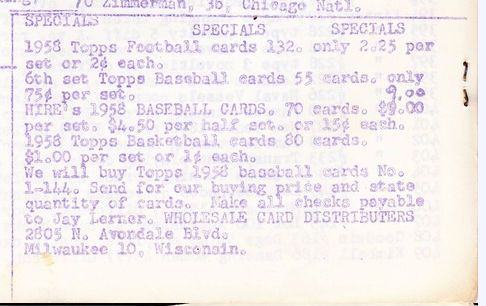 In the August 1, 1959 CCB, Yeko had a full-page ad (below), a few pages after a quarter-page ad by a young "Lawrence C. Fritsch" of Stevens Point, Wisconsin (the earliest ad of his that I've seen, which I may post later). Yeko was selling single cards from all the Topps and Bowman baseball and football sets after 1950 (the same price for any card from a set), and from some non-sport sets. Below that is Yeko's ad from the August 1, 1961 CCB, this one more focused on recent cards and offering some sets in addition to the singles, including 1961 Topps baseball for $11.95. 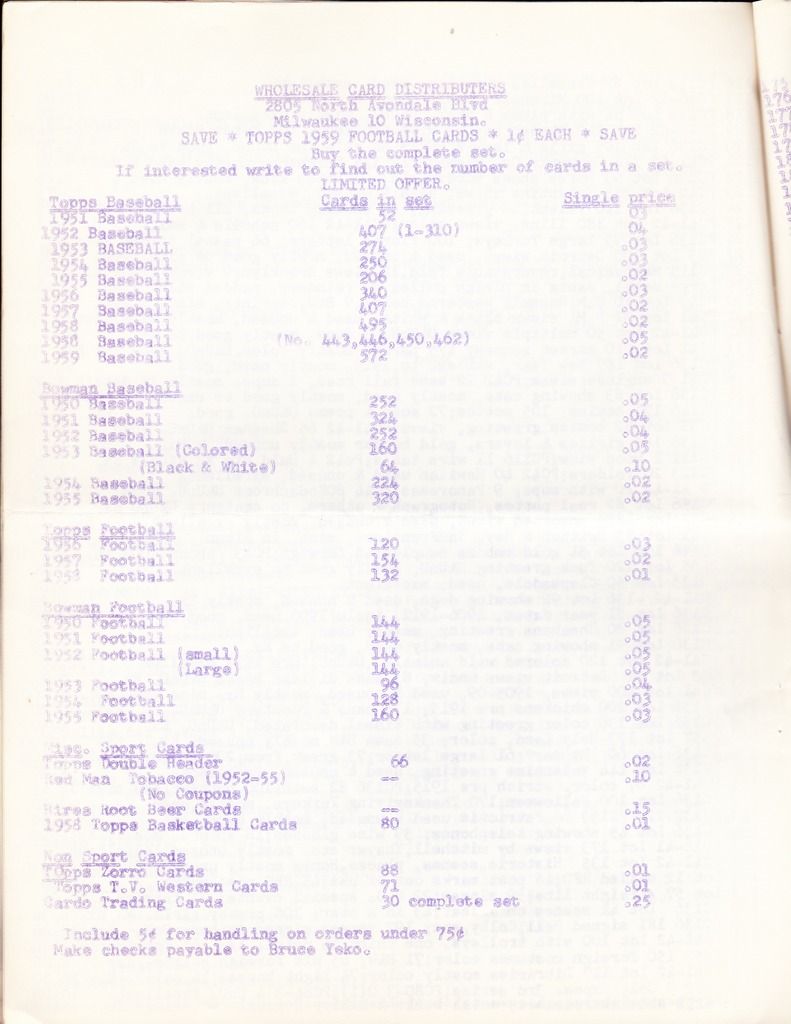 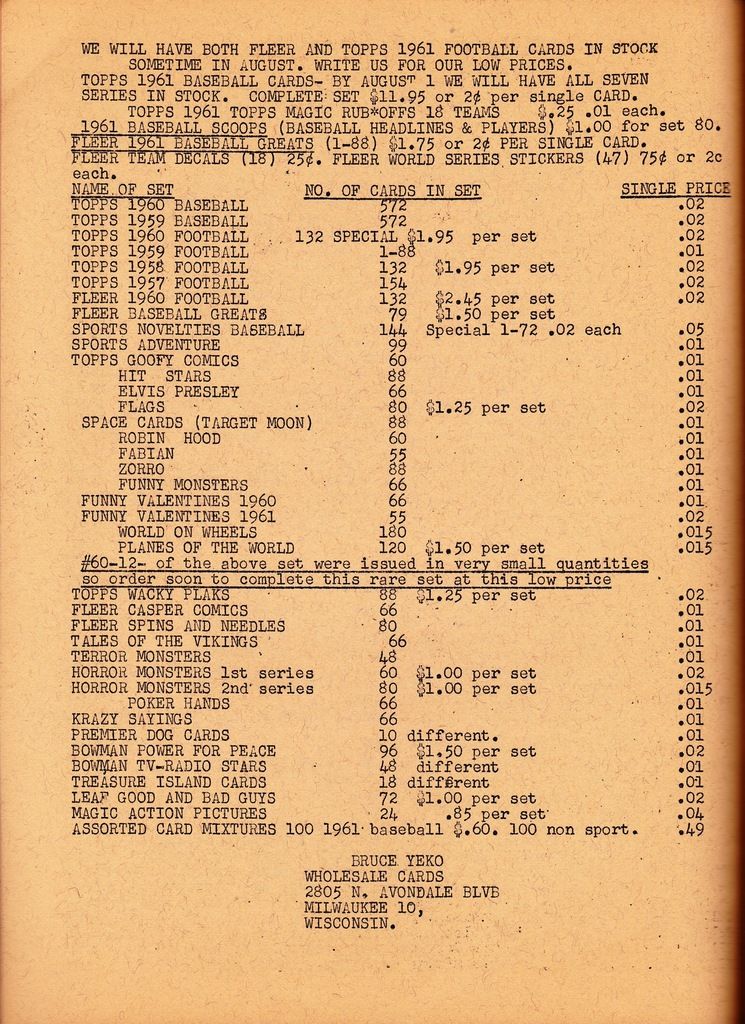 In the spring of 1962, Yeko graduated from UW-Milwaukee with a degree in accounting, and applied for jobs with each of the "big seven" accounting firms (as they then were). He only applied for jobs in New York, because his goal was to move there and pursue his love of musical theater, working a job during the day and going to Broadway musicals at night, ideally while keeping his card business going part-time. Six of the accounting firms rejected him, but Touche Ross (now part of Deloitte) offered him a job in the Big Apple, so he moved there in the summer of 1962. But after nine months at the job, including one busy tax season, Yeko realized that he didn't like accounting and wasn't very good at it, so he quit, and starting in the summer of 1963 he made his card business into a full-time "day job" to pay for his Broadway habit. He began advertising more (including a full-page ad in each issue of Card Collector's Bulletin starting in August 1963), typed up a price list, and began sending out a monthly flyer highlighting the latest releases. Below is the front and back of Yeko's flyer dated September 15, 1963 (condensed into one image), and the first page of his four-page price list. Notice that he was still charging the same price for any card in each set, except for tougher series, error cards, and short prints from 1958 and 1961. Note also the plug for The Sports Gazette, a cheaply mimeographed hobby publication in which Yeko had been advertising since the March-April 1963 issue, and for which he wrote a "Mr. Answer Man" column in the first three issues of 1964. 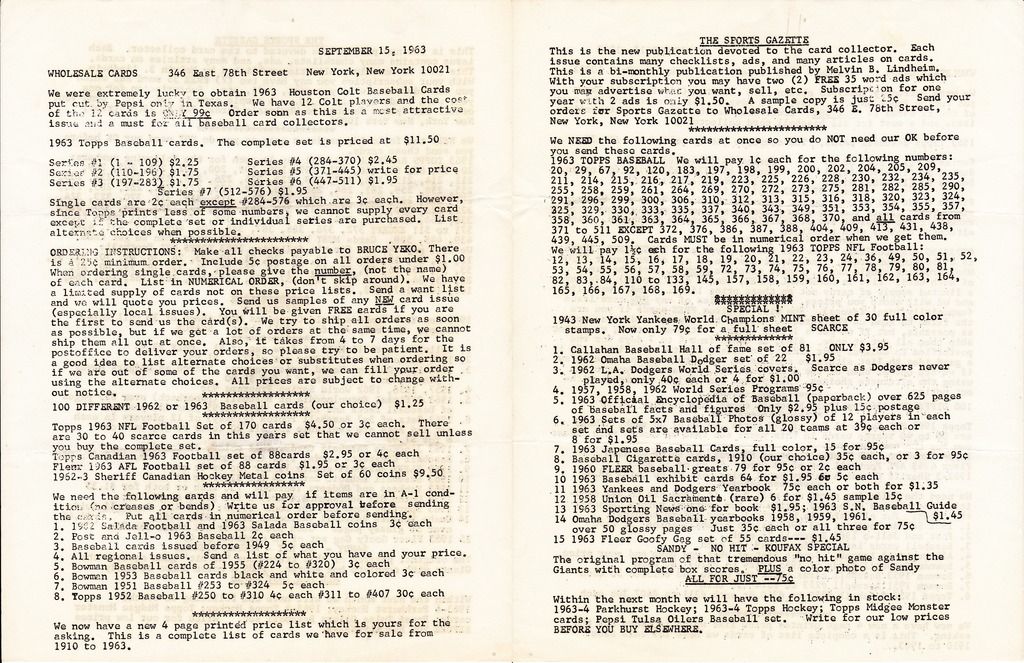  When Yeko became a full-time card dealer in the summer of 1963, one of his main competitors was Woody Gelman and the Card Collectors' Company, though Yeko and Gelman were on friendly terms. His other major competitor was Marshall Oreck, who now owned Gordon B. Taylor's former inventory of cards. When Taylor went out of business in late 1961, he sold the cards to M. A. Kohler, who turned around and sold them to Oreck a year later. Oreck became a full-time dealer and went all out in terms of marketing, advertising widely and putting out a slick 24-page, 8.5"x11" price list in early 1963. Below is the cover and inside cover of that price list, along with the first page of the list itself. Oreck was charging a premium for team cards and checklists, as well as for tougher series and occasionally other cards, though it's sometimes hard to see why he was charging extra for certain cards and not for others. No cards from 1962 or 1961 Topps commanded a premium, while there were three in 1960 (Billy Pierce, Willie McCovey, and Mickey Mantle) and four in 1959 (Stan Musial, Yankees team, Harmon Killibrew, and Roy Campanella). From earlier years, the only non-scarce cards for which Oreck was charging extra were 1957 #'s 253-264 (?), 400 (Dodgers' Sluggers), and 407 (Yankee Power Hitters); 1956 #166 (Dodgers team); 1955 Topps #210 (Duke Snider); 1954 Topps #1 and 250 (Ted Williams); 1953 Bowman B&W #39 (Casey Stengel); 1953 Bowman color #32 (Stan Musial); and 1952 Bowman #196 (Musial). Those are mostly star cards, but lots of star cards in those sets are not included in this list. 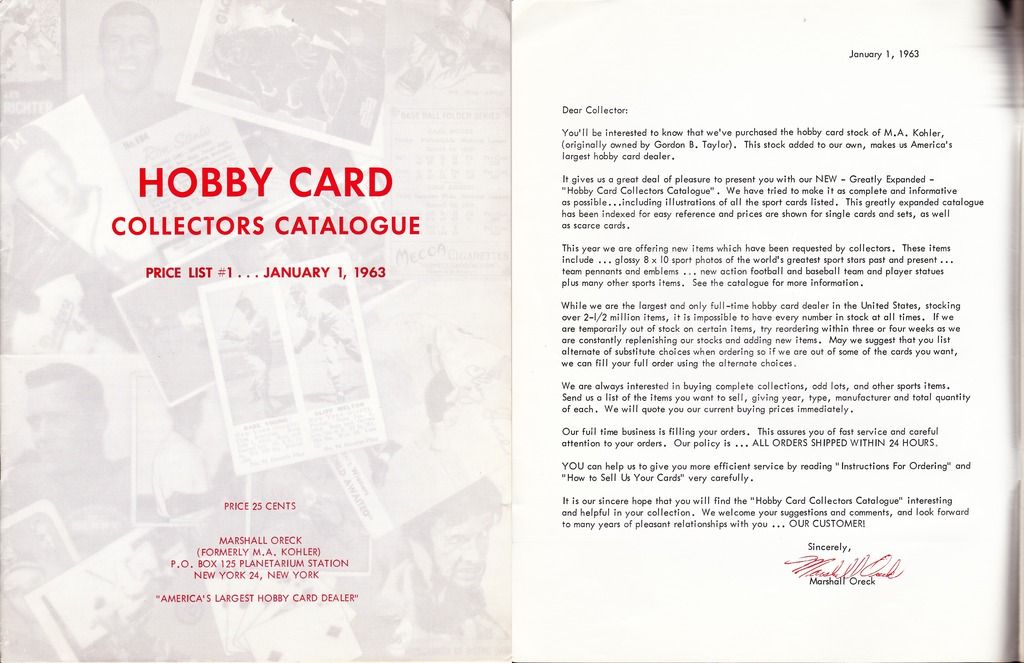 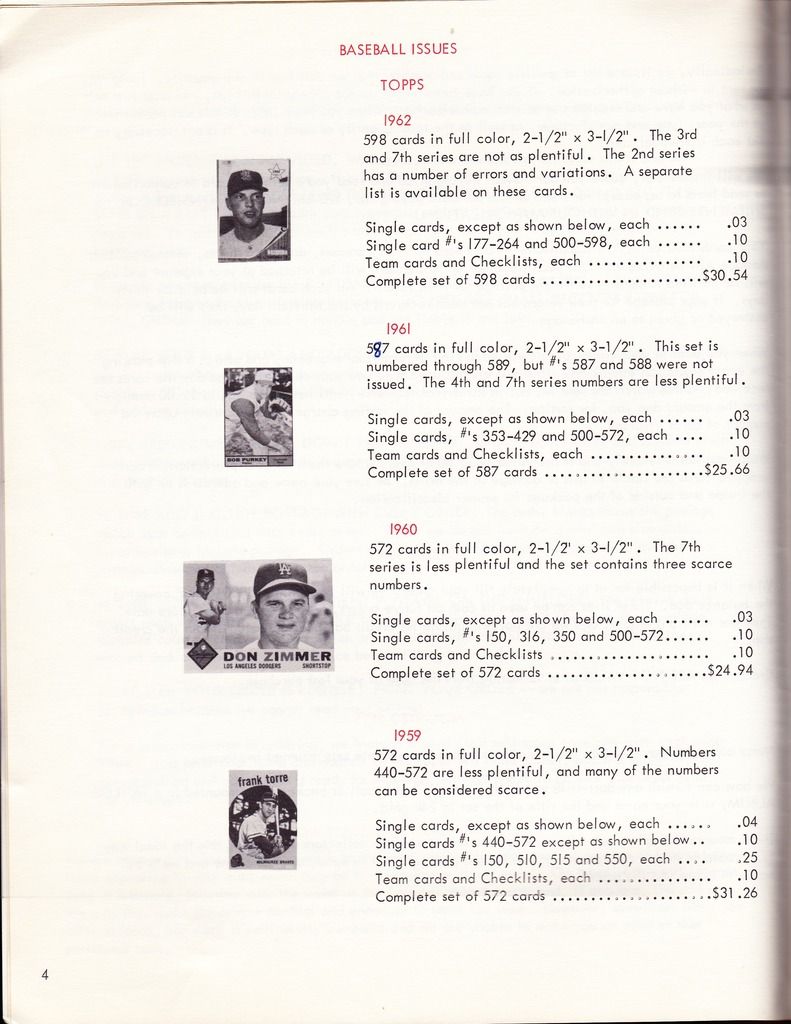 In this first price list, Oreck also announced a Collectors' Directory, which was already in its second issue and was going to come out (he said) every three months. I have the third issue, which was apparently the last one, because Bruce Yeko was still selling it several years later. Below is the cover and the first page (condensed), including a listing for a young Mike Aronstein, future founder of TCMA. 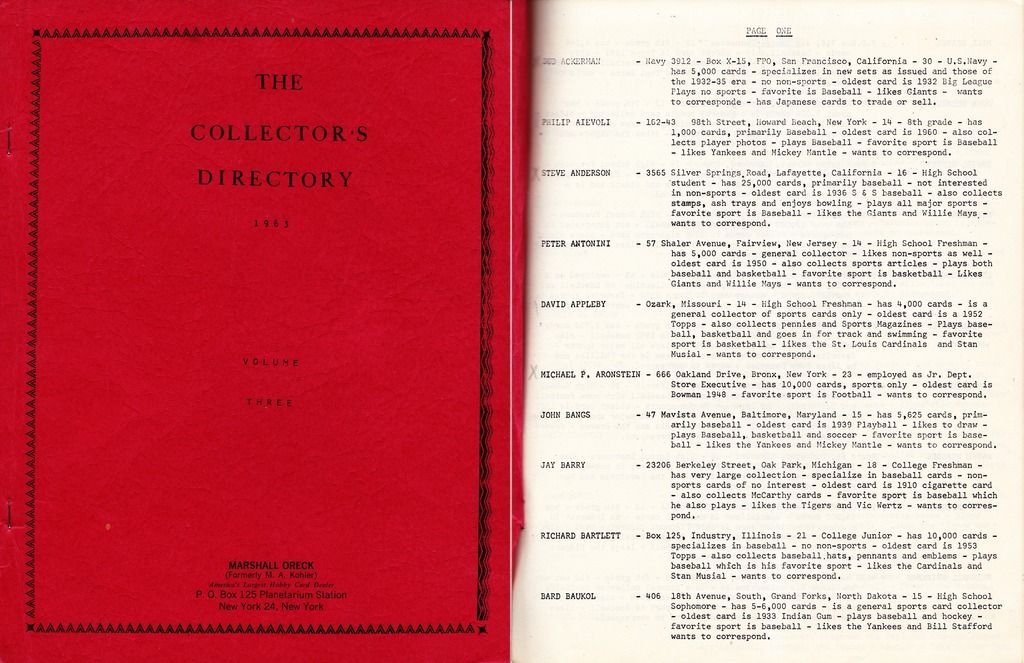 Oreck's second price list from 1964 does not differ significantly from the first, except that some of the prices have gone up a little, and it includes the 1963 Topps and Bazooka cards. In 1963 Topps he was charging 3 cents for most cards, but 10 cents for teams and checklists, series 4 cards (#264-352), #120 (Roger Maris), #250 (Stan Musial), #368 (Ed Bailey), #375 (Ken Boyer), #380 (Ernie Banks), #382 (Ralph Houk), #401 (Jim Bouton), and #410 (Earl Battey). I can understand Maris, Musial, and Banks, but why these other guys, and not Mantle, Mays, Aaron, or Clemente? It was Oreck's third price list, dated January 1, 1965, where he finally got his act together and began consistently charging extra for cards of big-name stars. Below are the relevant pages from that catalogue. He was charging extra for the biggest stars in all the Topps and Bowman sets, including Mantle and Mays, listing most of them by name rather than just by number. Amazingly (from our perspective), the one exception is the 1952 Topps high numbers, which he appears to have been selling for $1.00 each -- including Mantle, Robinson, Campanella, and the other stars in that series. Maybe he thought that since they were already selling for a premium, it wasn't fair to charge a double premium; or maybe he didn't have 52 Topps high numbers in stock consistently enough to worry about pricing individual cards. 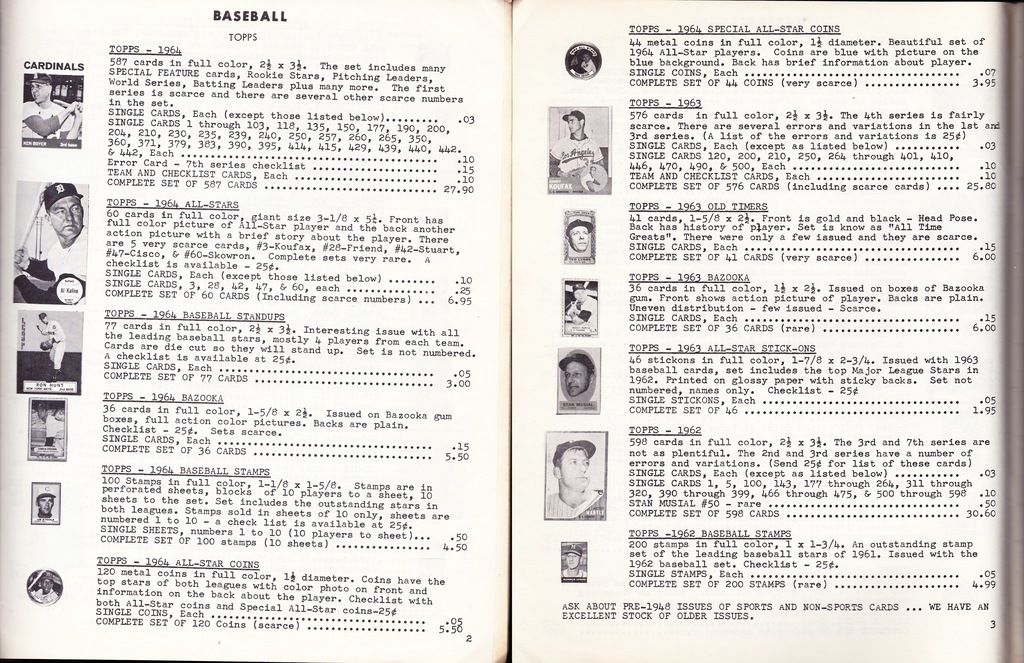   While it might appear that things were going great for Oreck, he was actually looking to get out of the card business. His brother David had started a vacuum cleaner company in 1963, the same year that Marshall launched his card business, and Oreck vacuum cleaners were becoming so popular that the business was growing rapidly. Oreck offered to sell his 4 million card inventory to Bruce Yeko for $10,000, but Yeko initially declined. Eventually, though, Yeko accepted the offer in early 1966, and Marshall Oreck became an executive with Oreck Corporation. Before this, Yeko had only sporadically charged extra for star cards. I have his flyers from May 15 and June 15, 1965, in which he was selling singles from the new 1965 Topps baseball set for 3 cents each, except Willie Mays (#250) and Mickey Mantle (#350) were 10 cents each. But in his 4-page price list from that year, the first page of which is below, he was still charging the same for all the cards in a given set. 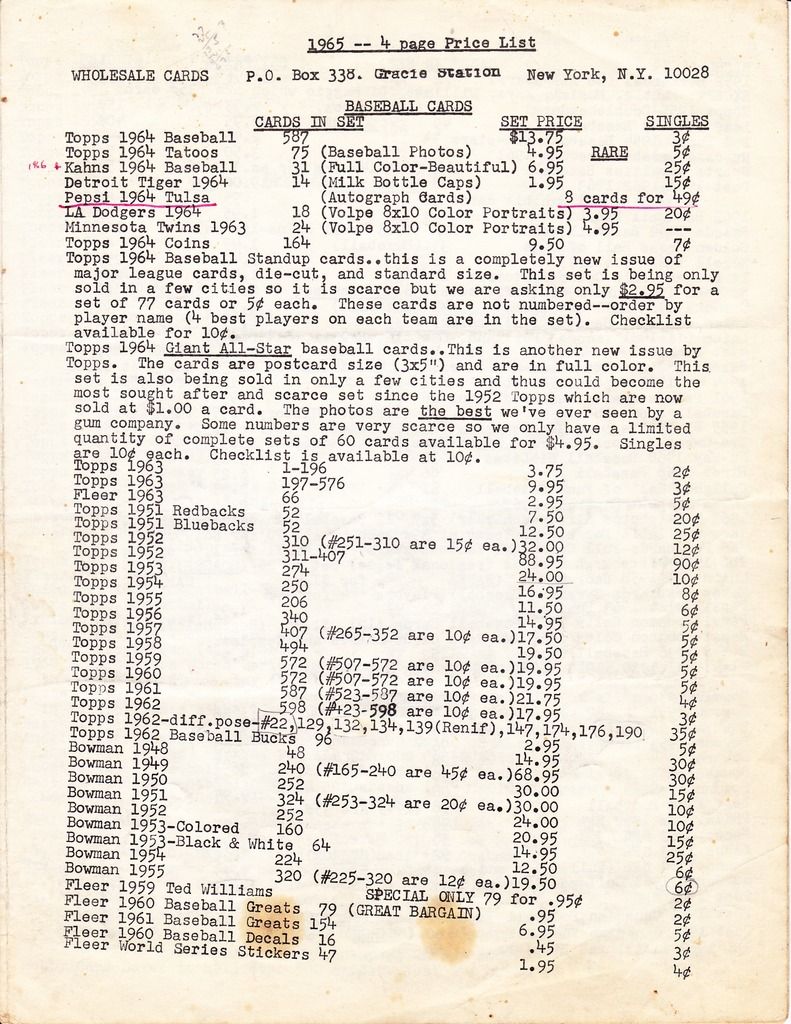 All that changed once Yeko bought out Oreck. He took over Oreck's catalogue, using the same cover with his name and address substituted (see them side by side below), though he made it smaller and printed it on newsprint rather than nicer paper. More importantly, he enthusiastically adopted Oreck's practice of charging more for star players, because it turned out that people were willing to pay the higher prices, thus making him more money. Somewhat disingenuously, Yeko labeled these higher-priced cards as "scarce", even though for the most part they were just as common as the other cards. Here are the relevant pages from Yeko's 1966-67 catalogue. With his stock combined with Oreck's, he could offer more than either one could before. Note that he was selling the 1952 Topps set, including the high numbers, for $125; on another page (which I didn't scan) he was offering 1933 Goudeys for 60 cents each, and the set of 240 for $144.  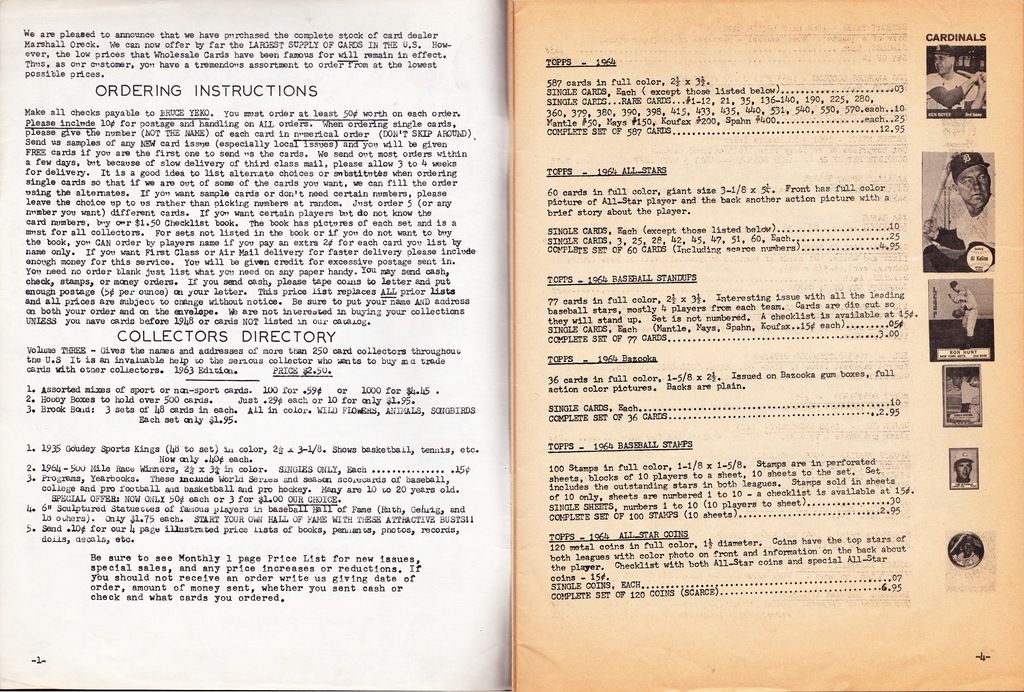   Recall that it was Woody Gelman's Card Collectors' Company that had originally started charging extra for some star cards, though on an inconsistent basis. While all that we saw above was going on between Oreck and Yeko, Gelman's price lists hardly changed. In his price list no. 19, dated January 15, 1967, he still was not charging a premium for any individual Topps cards from 1951 through 1961, and the only ones after that for which he was charging extra were 1962 Maris and Mantle, 1963 Maris and Mantle, 1964 Mantle, 1965 Mantle, 1966 Mantle and Mays, and 1967 Mantle and Mays. But in his price list no. 20, dated January 15, 1968, Gelman finally buckled and began charging more for star cards across the board. He had three price levels for each set: commons, cards that cost a bit more (minor stars), and "very rare cards" (the biggest stars). The idea that only "rare" or "scarce" cards should cost more remained a stubborn idea within the hobby, but at least by the late 1960s the prices of star cards were starting to catch up with market realities. 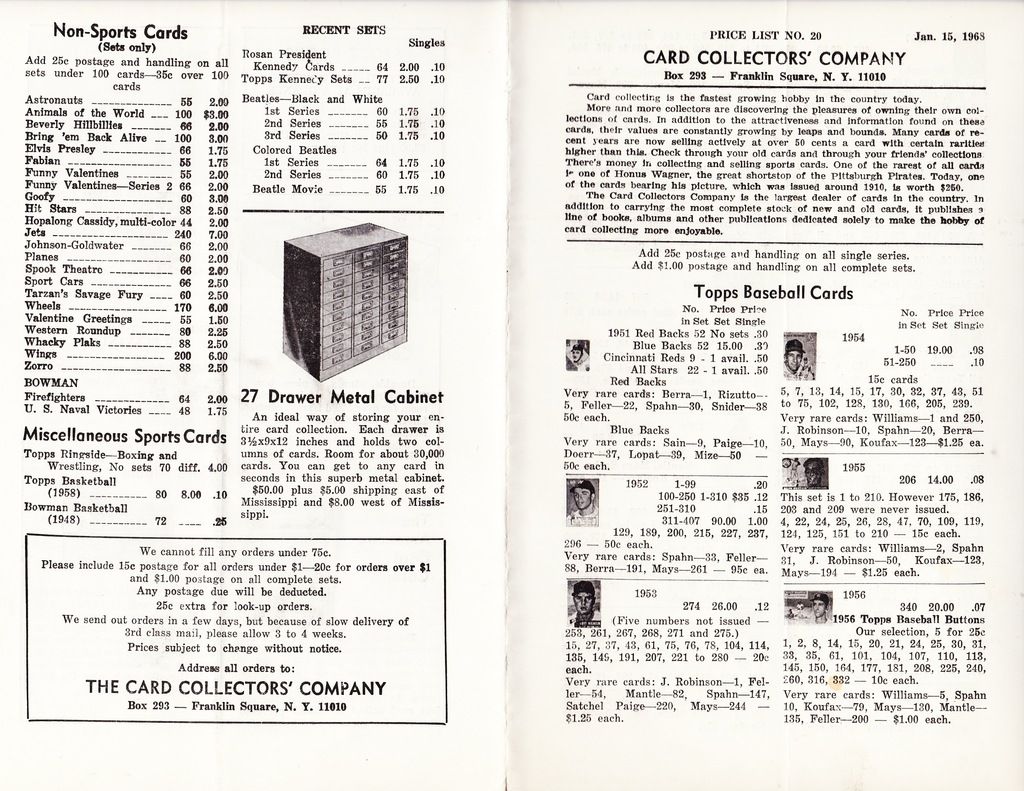 
|
|
|
 Similar Threads
Similar Threads
|
||||
| Thread | Thread Starter | Forum | Replies | Last Post |
| Hobby history: Card dealers of the early 1960s, part 1: Taylor vs. Gelman | trdcrdkid | Net54baseball Vintage (WWII & Older) Baseball Cards & New Member Introductions | 25 | 09-14-2021 02:04 PM |
| Hobby history: Card dealers of the 1950s | trdcrdkid | Net54baseball Vintage (WWII & Older) Baseball Cards & New Member Introductions | 21 | 01-01-2017 02:45 PM |
| Card Collectors Bulletin and early hobby history (in Sport Fan) | trdcrdkid | Net54baseball Vintage (WWII & Older) Baseball Cards & New Member Introductions | 1 | 04-30-2016 09:31 PM |
| 1965 Rich Egan article on Card Collectors Bulletin, early hobby history | trdcrdkid | Net54baseball Vintage (WWII & Older) Baseball Cards & New Member Introductions | 2 | 04-26-2016 05:28 PM |
| Card Collector's Bulletin, 8/1/69: Lionel Carter, hobby history | trdcrdkid | Net54baseball Vintage (WWII & Older) Baseball Cards & New Member Introductions | 4 | 03-03-2016 08:39 AM |